
|
|
7 December, 2001

This 2001-2002 field season, the National Science Foundation approved eight teachers to parcticipate in field research projects in Antarctica. Although, we all came to Antarctica with different scientists at different times, I felt fortunate to have had the opportunity to briefly cross paths with most of these teachers at some point during my time at the McMurdo Research Station. Jennifer Curtis worked with the TransAntarctic Mountains Seismic Experiment, while Tim Vermaat parcticipated on a research project on Mt. Erebus, the southern-most active volcano in the world. Although, I didn't get pictures of the other teachers, I later met Juanita Ryan before she headed out on her snowmobile to search for meteorites. I met Jason Petula when he arrived from the South Pole before my scheduled flight home. I also met Jan French who came to Antarctica with the International ITASE group. We weren't able to meet Susan Cowles who was stationed on the other side of Antarctica. She came across the Drake Passage to work on a long-term ecological project at Palmer Station on the Peninsula. The National Science Foundation has provided us with one of the greatest learning experiences of our lives. Our goal is to reach out to others to share our experiences along with the incredible research taking place in Antarctica.

I also met another TEA, Marietta Cleckley, who is working in McMurdo Station on a research project to monitor the impact humans may be having on the environment around the McMurdo area. This research station accommodates up to 1200 people during the austral summer. The U.S. Antarctic Program enforces strict regulations to keep Antarctica pristine, and this research is yet one more example of the NSF's commitment and responsibility to the Antarctic environment. Marietta is shown here with art work sent by students from her high school, Uniondale High School, for the upcoming "art show" in McMurdo.

"Spike" gets a closer look at the artwork sent to Marietta Cleckley from the talented art students at Uniondale High School in New York. Some of the artwork was displayed as a perfect fit around soda pop and fruit drink cans.
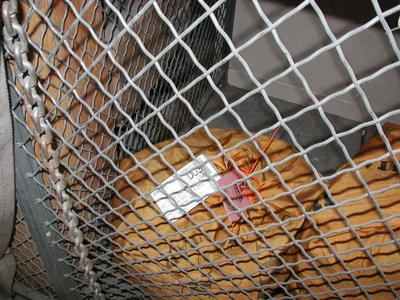
Everything has a bar code in order to track each pallet. The mail is tagged in bags and locked into a storage area in preparation for its scheduled flight off the continent.
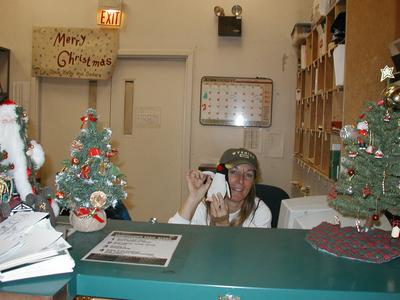
When I went to the mailroom to stamp postcards to send back to my students, I met the mail room currier, Barbara Teuscher. She is a teacher from New Mexico who came to Antarctica with her husband Bob Teuscher. Bob is a heavy equipment operator with Fleet Ops. It was hard meeting up with him (for a photo with the heavy equipment) during his workday because he was working to prepare the new runway. Every year when the ice begins to melt, the runway on the sea ice is moved to the ice shelf. Barbara rotates working in the mail room for two weeks, then the next two weeks, she goes around to the different departments and buildings in the McMurdo complex to deliver mail.
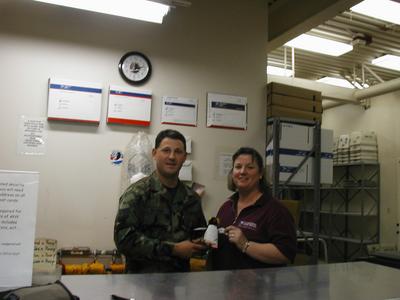
While mailing a package at the post office, I met Christine Hush who has worked in Antarctica for the past ten seasons. During the off-season, she is employed full time with Raytheon Polar Services in "Shipping and Receiving" placing orders for scientists. It is surprising to use U.S. postage to mail letters and packages home from Antarctica. The mail is transported to Christchurch by military APO (Air Post Office) services, then on to the American West Coast. TSgt Tom Mazzoni is the technical sergeant and post master at the military post office in Christchurch, New Zealand. He is in Antarctica this season as the military representative for this program. I used American currency to pay for the postage. When I visited the nearby New Zealand Scott Base, I used New Zealand currency or a credit card. No one country owns Antarctica, but 42 nations have signed an International Treaty to keep Antarctica for science research and peaceful purposes. Twelve countries signed the original treaty: The United States, Russia, France, Belgium, South Africa, Chile, Argentina, Australia, New Zealand, Japan, Norway, and the United Kingdom. Where is Antarctica? It is about 2000 miles from Australia and New Zealand. It took me 5 hours to fly to McMurdo from Christchurch, New Zealand on a military C-141, and it will take me 7 hours to fly back on a C-130. The Antarctic Peninsula is only 650 miles from South America, but the Drake Passage is one of the roughest sea passages in the world. Mail and shipments coming into and leaving Antarctica are much appreciated and anticipated in this part of the world!
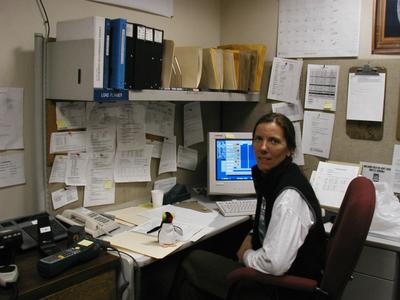
Stephanie Schmidt is working her first season in Antarctica as a cargo load planner. She is from Seattle, Washington, where she worked as an information specialist with Microsoft (cataloging and indexing web sites). She is scheduled to work this Antarctic season from October 19- February 24, 2002. She keeps track of cargo coming into McMurdo, pallets loaded with supplies and equipment sent to field camps, and incoming/outgoing mail. She works a 12 hour shift, 5 days a week, but the cargo operation is a 24/7 operation. McMurdo is a major cargo hub for cargo coming in by plane from Christchurch, New Zealand, the South Pole, or remote field camps, such as Siple Dome, Byrd Surface, and Vostok.
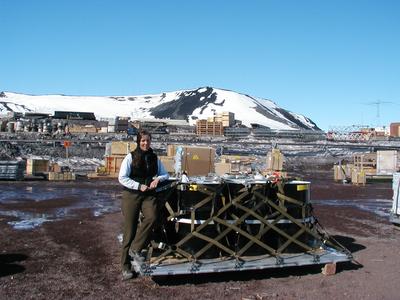
Cargo is put on steel pallets, which are loaded with food, fresh vegetables, supplies, and science equipment. Some may hold hazardous equipment, chemicals, and fuel drums. Since the South Pole Station is under construction, many flights with lumber and building supplies are sent over 800 miles from the McMurdo complex to the South Pole Station. The military LC 130 with skis makes flights across the continent, while the wheeled C-130 flies to and from New Zealand.
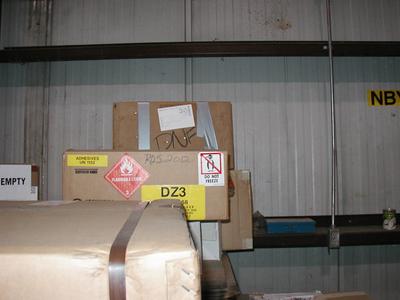
The cargo planner uses the computer, radio, and big white message boards to keep track of the cargo at all times. The cargo must be staged ahead of time the night before and loaded two hours before departure in order to keep on schedule. This is a busy place, which can have five flights to the South Pole in one day. This operation details every thing coming into and going out of McMurdo by military plane. Keeping on schedule and tracking the cargo keeps everything running smoothly.

Kristan Hutchison and Mark Sabbatini are a husband/wife team from Juneau, Alaska, who came to Antarctica as journalists for the Antarctic Sun. This weekly newspaper is published during the austral summer at McMurdo Station in Antarctica for the United States Antarctic Program. The newspaper, which comes out each Sunday, features stories about science and life in this program, including Palmer Station, the South Pole, and research vessels. Kristan is the lead journalist this year. Mark had worked as an editor, reporter, and photographer for daily newspapers in Washington, Wyoming, Los Angeles, and Alaska. They each bring 10 years experience of journalism to their positions. Melanie Conner, not pictured, is a photojournalist with stints in Oregon, Utah, Missouri, Washington, DC, Hong Kong, and Korea. This newspaper is published from mid-October to the first week in February. Issues may be accessed on-line at www.polar.org/antsun. It is a wonderful resource with information concerning science and life in Antarctica. This web page brings polar news to your home by archiving past issues, answering questions about Antarctica, and providing links to other Antarctic resources.
Contact the TEA in the field at
.
If you cannot connect through your browser, copy the
TEA's e-mail address in the "To:" line of
your favorite e-mail package.
|
